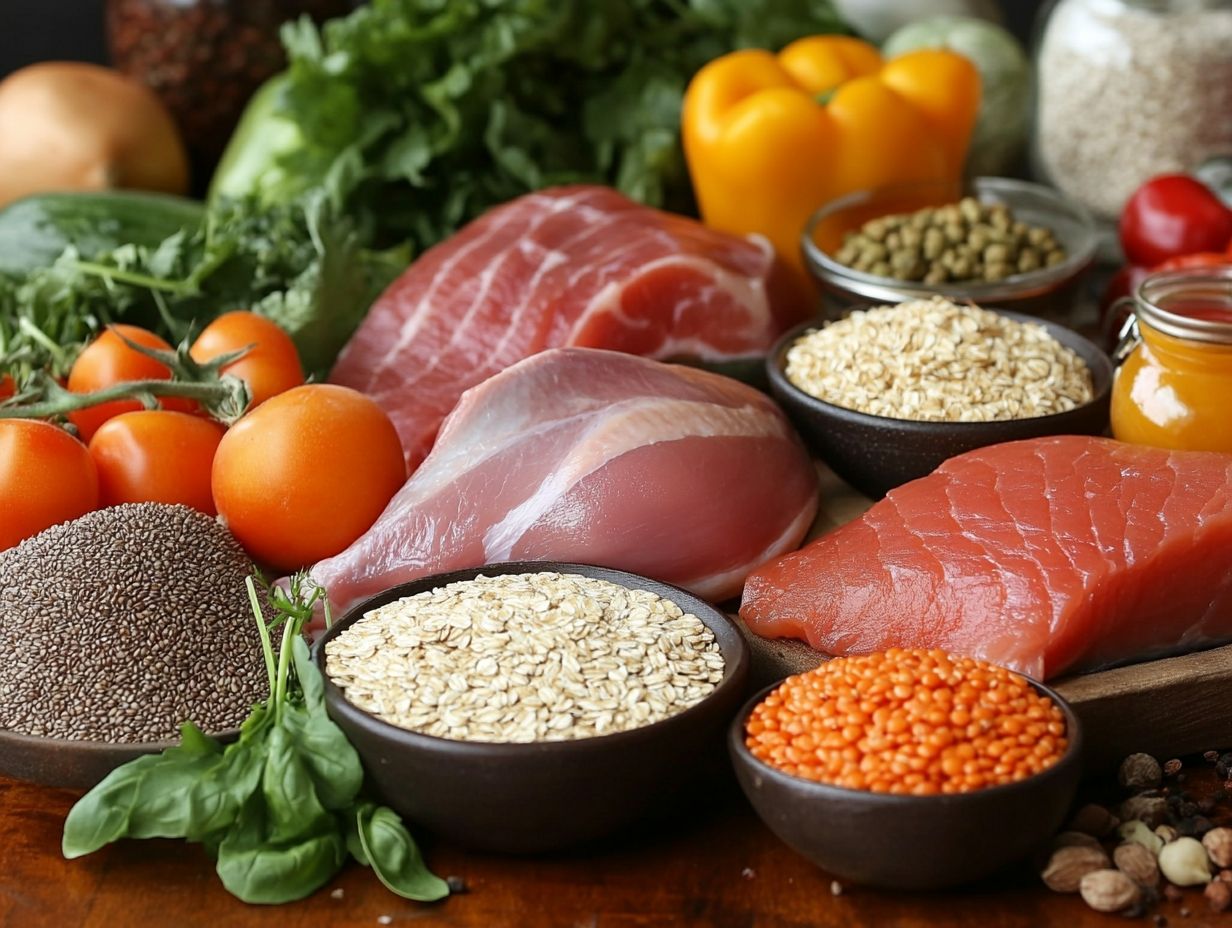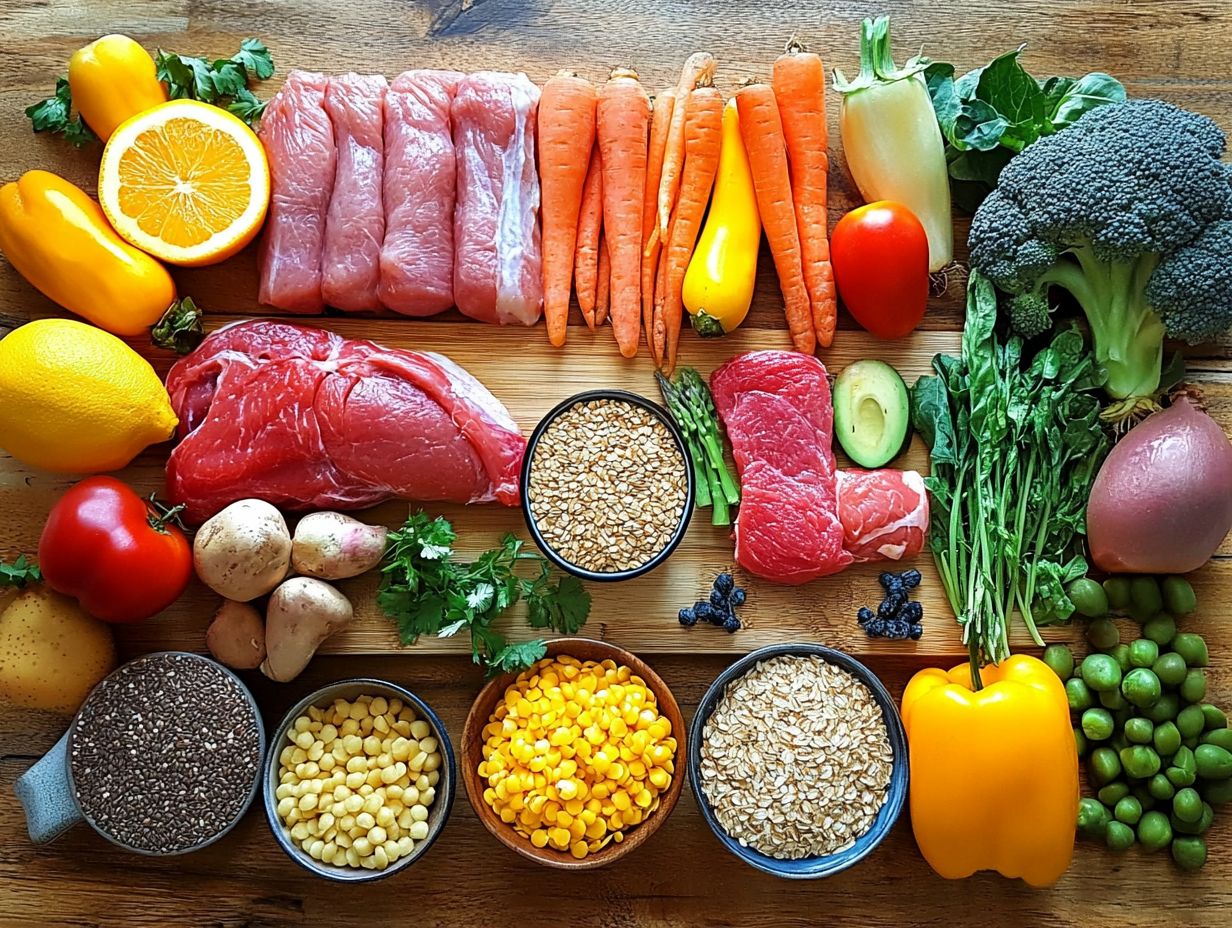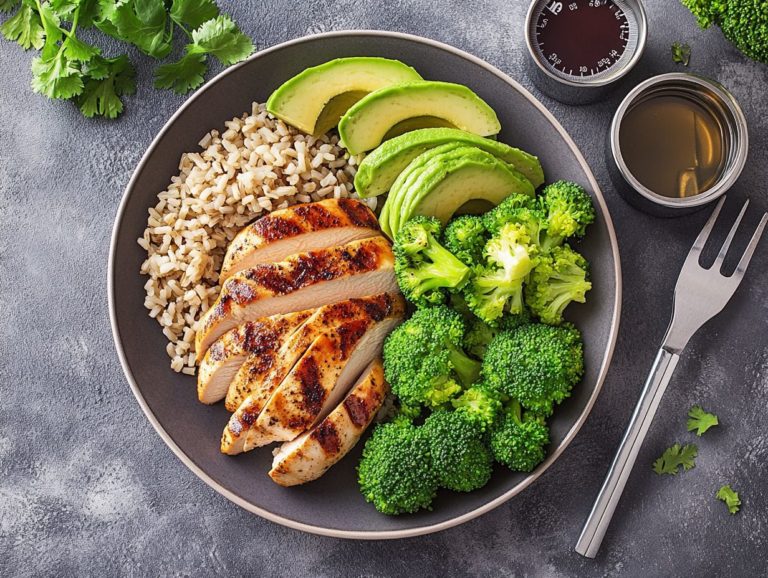10 Essential Foods for Meal Planning
Eating well revolves around making informed choices, and meal planning can truly be your secret weapon.
Consider these ten essential foods that will elevate your meal prep, ranging from lean proteins to vibrant fruits and vegetables. By incorporating these nutrient-rich ingredients into your meals, you’ll not only boost your health but also enhance your culinary masterpieces.
Here are practical tips for seamless meal planning that will save you both time and money. Are you ready to transform your kitchen routine? Let s jump into this exciting journey of meal planning!
Contents
- Key Takeaways:
- 1. Lean Proteins
- 2. Healthy Fats
- 3. Whole Grains
- 4. Fresh Fruits and Vegetables
- 5. Low-Fat Dairy Products
- 6. Legumes and Beans
- 7. Nuts and Seeds
- 8. Herbs and Spices
- 9. Healthy Oils
- 10. Fermented Foods
- How Can Meal Planning Help with Healthy Eating?
- What Are the Benefits of Incorporating These Foods into Your Meal Plan?
- How Can These Foods Be Used in Different Meal Types?
- What Are Some Tips for Incorporating These Foods into Your Diet?
- How Can Meal Planning Help with Budgeting and Saving Money?
- What Are Some Common Mistakes to Avoid When Meal Planning?
- Frequently Asked Questions
Key Takeaways:

- Include lean proteins in your meal planning to support muscle growth and repair.
- Incorporate healthy fats, like avocado and olive oil, for heart health and satiety.
- Choose whole grains for sustained energy and fiber intake to aid in digestion.
1. Lean Proteins
Lean proteins are crucial for maintaining a balanced diet, serving as the vital building blocks for muscle repair and overall wellness. This is vital for busy people seeking nutritious meals that fit into their hectic lives.
By incorporating lean proteins such as salmon, tempeh, and legumes into your dinner rotation, you can elevate your meals while adhering to the Dietary Guidelines for Americans.
These protein sources not only aid in muscle development but also help curb the urge for unhealthy snacking. With a variety of options like grilled chicken breast, hearty bean salads, and tasty fish tacos, meal prep can transform into an enjoyable culinary adventure.
For example, whipping up a lentil stew not only packs in fiber and essential nutrients but also warms the soul. Meanwhile, baked chicken can be seasoned in countless ways to match your unique tastes.
By experimenting with these versatile ingredients, you can effortlessly craft nutrient-rich, satisfying dishes that keep your energy levels high ideal for those navigating busy schedules.
2. Healthy Fats
Incorporating healthy fats into your diet is essential for optimal brain health and overall wellness. Olive oil stands out as one of the best additions, thanks to its numerous nutritional benefits and versatility in cooking. Healthy fats not only enhance flavor but also support the absorption of nutrients from other foods.
Consider avocados and nuts as additional sources of these beneficial fats, vital for reducing the risk of heart disease and promoting cognitive function. Avocados, rich in monounsaturated fats, and a variety of nuts like almonds and walnuts deliver a hearty dose of omega-3 fatty acids, which are linked to improved brain performance and better heart health.
Making these foods a part of your daily meals is effortless. You can simply drizzle olive oil over your salads, spread avocado on toast, or indulge in a handful of nuts as a snack between meals. This way, you can boost your overall nutrition while savoring delicious flavors.
3. Whole Grains
Whole grains are an essential element of healthy eating, providing a wealth of nutrients that meet your dietary needs while promoting a balanced diet especially when you incorporate them into your grocery shopping and meal planning strategies. Foods like quinoa, brown rice, and whole grain pasta deliver essential fiber and make your meals healthier and more satisfying.
These grains are pivotal for digestive health, supporting good gut bacteria and aiding in regularity, which can significantly enhance your overall well-being. By integrating whole grains into your breakfast with options like oatmeal or whole grain bread, and adding them to salads, stir-fries, and soups, you can relish their versatility across various cuisines.
Whole grains not only help you maintain stable energy levels throughout the day but also play a role in reducing the risk of chronic diseases. This makes them an invaluable choice for anyone looking to elevate their health and wellness.
Start your meal planning journey today and enjoy the benefits of a healthier lifestyle!
4. Fresh Fruits and Vegetables
Fresh fruits and vegetables aren t just good for you; they can transform your meals into colorful masterpieces! They are absolutely essential for a well-rounded diet, offering vital vitamins and minerals that greatly contribute to your overall health and wellness.
This is especially true when you focus on a diverse array of vegetables, including those dark leafy greens that offer significant nutritional benefits. By emphasizing clean eating and incorporating colorful produce into your meals, you not only satisfy your cravings but also ensure a nutrient-rich diet.
When you include a variety of fruits and vegetables in your diet, you significantly boost your intake of antioxidants and phytochemicals, which are natural compounds found in plants that offer various health benefits. These are crucial for combating inflammation and lowering the risk of chronic diseases.
Dark leafy greens like kale and spinach are nutritional powerhouses. Don t overlook citrus fruits like oranges and grapefruits; they provide refreshing flavors along with a hefty dose of vitamin C to support your immune system.
For meal prep, get creative by making a berry salad that can be enjoyed all week. Even simple smoothies that blend bananas with a handful of spinach and a splash of orange juice can make consuming these nutrient-rich foods both delightful and effortless, especially when you incorporate 10 superfoods to add to your pantry today.
5. Low-Fat Dairy Products
Low-fat dairy products are an excellent source of calcium and protein, making them a perfect ally for your healthy eating journey. They allow you to manage portion sizes while still meeting your dietary goals, especially if you lead a busy lifestyle.
Options like yogurt, cottage cheese, and low-fat milk not only enhance your meals but also deliver essential nutrients. These nutrient-packed foods promote bone health by providing the calcium necessary to support bone density something that’s especially important as you age.
Their high protein content also aids in muscle maintenance, making them a superb choice for anyone focused on staying fit. To effortlessly weave these products into your daily routine, consider adding yogurt to your smoothies for a refreshing breakfast or snack.
Mixing cottage cheese with fruit creates a quick and delightful dessert. Using low-fat milk in your oatmeal elevates your morning meal, making it both nutritious and enjoyable.
These simple yet healthy recipes not only enhance your nutrition but also introduce variety into your everyday meals. This makes it easier for you to enjoy all the benefits that low-fat dairy has to offer.
6. Legumes and Beans

Legumes and beans, such as lentils and chickpeas, serve as exceptional plant-based protein sources that meet your nutritional needs and bring versatility to your meal prep. They enable you to craft a variety of satisfying dishes that align perfectly with healthy eating ideals.
With options like black beans, kidney beans, and split peas, each variety adds its unique flavors and textures to your creations. These legumes are brimming with essential nutrients like iron, magnesium, and folate, promoting heart health and aiding digestion.
For a quick weeknight meal, why not whip up a flavorful chickpea curry or a vibrant lentil salad? If you’re a pasta enthusiast, a nutritious black bean pesto could elevate your favorite noodles to new heights.
The possibilities are truly endless, making legumes and beans not just wholesome choices, but also exciting ingredients to elevate your culinary repertoire. Try them today to discover new flavors and boost your health!
7. Nuts and Seeds
Nuts and seeds are not just delicious; they re a powerhouse of healthy fats and essential nutrients that can boost your nutrition. Incorporating them into your meals and grocery list is a smart choice. Toss them into salads, blend them into smoothies, or snack on them directly for fantastic flavor and texture.
Take almonds, for instance. They re an excellent source of vitamin E and magnesium. Walnuts are loaded with omega-3 fatty acids, crucial for heart health. Chia seeds are tiny but mighty, packed with fiber and protein, making them perfect for overnight oats or smoothies.
Flaxseeds bring lignans and omega-3s to your table. They re easy to mix into baked goods or sprinkle over yogurt. Try toasting nuts and seeds for a crunchy topping or blending them into dressings for a nutrient boost.
8. Herbs and Spices
Herbs and spices are important in healthy cooking. They enhance flavor without adding extra calories, supporting your clean eating practices and inviting you to explore vibrant flavors. Fresh herbs and spices elevate taste while providing health benefits.
The lively aroma of fresh basil can transform a simple frittata into a gourmet experience. A dash of paprika adds smoky richness to hearty salads, making them feel robust and satisfying.
Experiment with combinations to create unique, delicious dishes. You can nourish your body and tantalize your taste buds, turning every meal into an exciting cooking journey.
9. Healthy Oils
Healthy oils, especially olive oil, are essential to your nutritious diet. They offer impressive health benefits and serve as versatile ingredients, enhancing your meal prep and making healthy eating delightful.
Incorporate a variety of healthy oils like avocado oil, coconut oil, and flaxseed oil to elevate your culinary adventures. These oils support heart health, improve skin conditions, and enhance nutrient absorption.
To maximize benefits, prepare marinades or salad dressings ahead of time. This allows flavors to meld beautifully and encourages you to choose full-fat, healthy oils over harmful options. Embrace this approach for a more balanced and nourishing diet.
10. Fermented Foods
Fermented foods are delicious and essential for gut health. They deliver probiotics, the good bacteria that help you feel great.
Foods like yogurt, sauerkraut, and kimchi are not just tasty additions; they support your digestion and immune system. Yogurt is a perfect breakfast with fresh fruits and crunchy nuts. A spoonful of sauerkraut adds a delightful crunch to your sandwich. Kimchi can spice up rice or noodle bowls with its zesty kick!
Want to include these foods in your daily routine? Start with a homemade smoothie using yogurt. Toss pickled vegetables into salads for a probiotic boost. Enjoy the numerous benefits of these tasty foods!
How Can Meal Planning Help with Healthy Eating?
Meal planning is an invaluable strategy for busy lives. It helps you create balanced meals and ensures you eat healthy, including incorporating healthy dessert ideas for meal planning.
Planning ahead saves time and reduces food waste. You ll use ingredients more efficiently and make healthier choices instead of grabbing takeout.
Create a meal calendar to outline what to prepare each day. This aligns your grocery list with your meals, making shopping easier. Choose quick recipes that can be made in advance, keeping you on track without stress.
What Are the Benefits of Incorporating These Foods into Your Meal Plan?

Add a variety of healthy foods to your meal plan for great health benefits. Incorporating essential spices for meal planning ensures a balanced diet that supports your well-being.
Including colorful fruits, leafy greens, whole grains, and lean proteins maximizes your vitamins and minerals. For example, fiber-rich legumes provide energy and improve digestion while antioxidant-packed berries boost immunity.
Try a Mediterranean quinoa salad with chickpeas, cucumbers, and feta cheese. This vibrant dish promotes heart health and satisfaction. Rotate different foods weekly to make meal planning a fun and enriching activity!
How Can These Foods Be Used in Different Meal Types?
Healthy foods fit seamlessly into your meals, transforming everything from breakfast frittatas to lunch salads and hearty pasta dishes for dinner. They bring both versatility and flavor to your table while meeting your nutritional needs. By exploring different cooking techniques and following 5 tips for planning balanced meals, each meal becomes an opportunity to indulge in nutritious and satisfying dishes.
For breakfast, consider crafting a colorful vegetable frittata loaded with spinach, bell peppers, and feta cheese. This delightful dish is packed with protein and essential vitamins to kickstart your day!
At lunchtime, a vibrant quinoa salad can be your go-to option. Toss together roasted chickpeas, cherry tomatoes, and a zesty lemon dressing for a fresh and exciting twist.
When evening rolls around, envision a wholesome whole wheat pasta dish, saut ed with zucchini, mushrooms, and a sprinkle of parmesan. This showcases just how effortlessly healthy foods can blend into various cuisines.
With every meal, you can harmonize flavor and nutrition with ease.
What Are Some Tips for Incorporating These Foods into Your Diet?
Incorporating healthy foods into your diet can become simple when you embrace practical tips that help with meal prep, smart grocery shopping, and a focus on clean eating. This approach allows you to enjoy nutritious options effortlessly every day. By being intentional with your food choices and planning ahead, you can elevate your meals while aligning with your dietary goals.
Start by outlining specific meals for the week and crafting a shopping list based on those recipes. This strategy helps you avoid impulse buys.
When you shop, keep your focus on the store’s perimeter, where you’ll typically find fresh produce, lean proteins, and whole grains.
Consider buying in bulk, especially for items like nuts, grains, and legumes. This not only saves you money but also minimizes packaging waste. Preparing meals in advance like cooking and portioning out lunches for the week can significantly reduce weekday stress and reinforce your commitment to healthier choices.
Engaging in mindful eating is equally important. By savoring each bite and tuning into your hunger cues, you’ll further solidify healthier habits in your daily routine.
How Can Meal Planning Help with Budgeting and Saving Money?
Meal planning isn t just a smart way to help with healthy eating; it s also an effective strategy for budgeting and saving on groceries. This allows busy women like you to make informed food choices without breaking the bank. By thoughtfully strategizing your meals and shopping lists, you can cut down on waste and ensure you are purchasing only what you truly need.
This approach encourages you to think ahead about your ingredients, leading to the delightful discovery of seasonal produce that typically comes at a better price and freshness. Watch weekly sales at your local grocery stores and weave those items into your meal plans for added savings.
Crafting a budget-friendly grocery list means distinguishing between necessities and extras while also planning meals around what you already have in your pantry. By blending these strategies, you will likely see significant savings over time, allowing you to enjoy delicious, nutritious meals without straining your finances.
Start your meal planning today and watch your savings grow!
What Are Some Common Mistakes to Avoid When Meal Planning?
When you’re diving into meal planning, it’s crucial to steer clear of common traps that can derail your healthy eating journey. Overcomplicating your meals, neglecting portion sizes, and skimping on versatile ingredients can all hinder your efforts. Incorporating 10 superfoods to support a healthy lifestyle can help you recognize and address these pitfalls, setting yourself up for a more successful and sustainable meal planning experience.
One common oversight is ignoring the power of seasonal ingredients. Not only do they elevate the flavor of your dishes, but they also help keep your grocery bills in check.
It’s easy to fall into the trap of creating overly ambitious meal plans that can quickly feel overwhelming. This often leads to burnout and a retreat from healthy choices. Embrace simplicity instead. Focus on a handful of key recipes that you can easily rotate throughout the week.
Adding a variety of textures and colors to your meals makes them more visually appealing and encourages you to stick with healthier eating habits. By prioritizing flexibility and creativity in your ingredient choices, consider incorporating protein-packed meal prep recipes to enhance your options. You’ll love how easy and enjoyable meal planning can be!
Frequently Asked Questions
What are the 10 essential foods for meal planning?

The 10 ingredients to always have for meal planning are lean proteins, whole grains, fruits, vegetables, healthy fats, dairy, nuts and seeds, herbs and spices, condiments, and healthy snacks.
Why are lean proteins important for meal planning?
Lean proteins are important for meal planning because they provide the body with essential amino acids, promote feelings of fullness, and help maintain muscle mass.
What are some examples of lean proteins?
Examples of lean proteins include chicken, fish, tofu, beans, lentils, and lean cuts of beef or pork.
How much whole grains should be included in a meal plan?
Whole grains should make up about 25-30% of your total daily caloric intake, which equates to about 3-4 servings per day.
What are some examples of whole grains?
Examples of whole grains include quinoa, brown rice, whole wheat bread or pasta, oats, and barley.
Why are fruits and vegetables important for meal planning?
Fruits and vegetables are crucial for meal planning because they provide essential vitamins, minerals, and fiber, and can help prevent chronic diseases. Adopting the 5 best practices for healthy meal planning can further enhance your dietary choices.
Ready to kickstart your meal planning journey? Start today and explore delicious recipes to make the process enjoyable!






